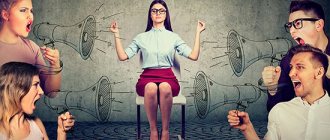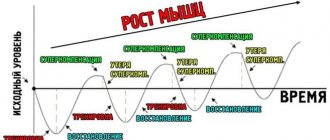Updated July 24, 2022 328 Author: Dmitry Petrov
Hello, dear readers of the KtoNaNovenkogo.ru blog. This term has taken root in the vocabulary of psychologists and psychiatrists, gamers and programmers, physicists and doctors. The word “trigger” comes out of the mouths of teenagers and PhDs. What is the reason for this popularity?
Well, it would be nice to at least in general terms understand its meaning in various areas, so as not to get into trouble. I think it’s time to figure out what a trigger is and what you eat it with (or is it inedible?).
The general essence of the concept of Trigger
The word “trigger” translated from English means “ trigger ”, “launch”. The literal translation reflects the essence of this concept:
an element that powers a system.
An analogy with a weapon will help to visualize the meaning of this mysterious term. When the trigger is triggered, the sound of a shot is heard (an active action occurs, the situation changes). A trigger is a pressed hook, in other words, a stimulating kick, Gagarin’s “Let’s go!”
It sounds vague because the term has multiple meanings. This is just the essence, and kicks, events and situations are different. This means that the term can have different meanings. Now let's move on to specifics, and everything will become clear.
Brief theoretical information
Triggers are designed to store binary information. The use of triggers makes it possible to implement RAM devices (that is, memory in which information is stored only for the duration of calculations).
However, flip-flops can also be used to build some digital memory devices, such as counters, serial-to-parallel converters, or digital delay lines.
RS trigger
The main trigger on which all other triggers are based is the RS trigger. The RS trigger has two logical inputs:
- R – setting 0 (from the word reset);
- S – setting 1 (from the word set).
The RS trigger has two outputs:
- Q – straight;
- Q - reverse (inverse).
The state of the trigger is determined by the state of the direct output. The simplest RS flip-flop consists of two logic elements covered by cross positive feedback.
Let's look at how the trigger works:
Let R=0, S=1. The lower logical element performs the logical OR-NOT function, i.e. 1 at any of its inputs leads to the fact that its output will have a logical zero Q=0. The output Q will be 1 (Q=1), because zeros are supplied to both inputs of the upper element (one zero from input R, the other from output). The trigger is in a single state. If we now remove the setting signal (R=0, S=0), the situation at the output will not change, because Although the lower input of the lower logic gate will receive a 0, its upper input will receive a 1 from the output of the upper logic gate.
It will be interesting All about Ohm's law: in simple words with examples for dummies
The flip-flop will remain in the single state until a reset signal is received at the R input. Let now R=1, S=0. Then Q=0, a =1. The trigger switched to “0”. If after this you remove the reset signal (R=0, S=0), then the trigger will still not change its state. To describe the operation of a trigger, a table of states (transitions) is used. Let's denote:
- Q(t) – state of the trigger before the arrival of control signals (changes at inputs R and S);
- Q(t+1) – trigger state after changes at inputs R and S.
Transition table of RS flip-flop in NOR basis
| R | S | Q(t) | Q(t+1) | Explanations |
| Information storage mode R=S=0 | ||||
| 1 | 1 | |||
| 1 | 1 | Unit setting mode S=1 | ||
| 1 | 1 | 1 | ||
| 1 | Zero setting mode R=1 | |||
| 1 | 1 | |||
| 1 | 1 | * | R=S=1 prohibited combination | |
| 1 | 1 | 1 | * |
An RS trigger can also be built using “AND-NOT” elements (Figure 2.2).
Inputs R and S are inverse (active level “0”). The transition (switching) of this trigger from one state to another occurs when one of the inputs is set to “0”. The combination R=S=0 is prohibited.
Transition table of RS flip-flop in the “2AND-NOT” basis
| R | S | Q(t) | Q(t+1) | Explanations |
| * | R=S=0 prohibited combination | |||
| 1 | * | |||
| 1 | Zero setting mode R=0 | |||
| 1 | 1 | |||
| 1 | 1 | Unit setting mode S=0 | ||
| 1 | 1 | 1 | ||
| 1 | 1 | Information storage mode R=S=1 | ||
| 1 | 1 | 1 | 1 |
Synchronous RS trigger
The RS flip-flop circuit allows you to remember the state of the logic circuit, but since a transient process may occur when the input signals change (in digital circuits this process is called “dangerous races”), you need to remember the states of the logic circuit only at certain moments in time, when all transient processes are completed, and the signal at the output of the combinational circuit corresponds to the function it performs. This means that most digital circuits require a synchronization signal (clock signal).
All transient processes in a combinational logic circuit must end during the period of the clock signal supplied to the inputs of the flip-flops. Flip-flops that remember input signals only at the time specified by the synchronization signal are called synchronous. A schematic diagram of a synchronous RS flip-flop is shown.
Transition table of synchronous RS flip-flop
| R | S | C | Q(t) | Q(t+1) | Explanations |
| 1 | Information storage mode R = S = 0 | ||||
| 1 | 1 | 1 | |||
| 1 | 1 | 1 | Unit setting mode S =1 | ||
| 1 | 1 | 1 | 1 | ||
| 1 | 1 | Zero setting mode R=1 | |||
| 1 | 1 | 1 | |||
| 1 | 1 | 1 | * | R = S = 1 prohibited combination | |
| 1 | 1 | 1 | 1 | * |
In table 2.3. By signal C we mean a sync pulse. Without a clock pulse, a synchronous RS flip-flop retains its state.
What is a trigger in psychology
Psychologists, speaking about a trigger, draw an analogy (what is this?) with a toggle switch, which temporarily “switches” a person’s thoughts and forces him to perform unconscious actions. “Switches” can be any signals entering the brain (auditory, tactile, visual, olfactory, gustatory).
Psychological triggers are a factor that is not traumatic in itself, but can cause strong re-experiencing of a past experience (or its individual elements).
How it works
A person has a developed sensory memory (even someone who was never able to learn “Lukomorye has green oak” at school), and this sometimes makes life very difficult.
Under the influence of irritants (smells, melodies, photographs, stills from films, snatches of phrases), strong memories awaken. Everything is long in the past, but the brain helpfully draws a parallel with the present. “The legends of deep antiquity” suddenly evoke real emotions, and often actions.
Psychological triggers vary in their impact. Some cause an uncontrollable storm of emotions and actions, while others are easily overcome.
Here is a visual picture:
- A girl who has undergone treatment for anorexia, when she sees a photograph of a very thin man, begins to starve herself again.
- An elderly person, noticing a queue in a store, without hesitation stands in it: they are offering something worthwhile (“they threw away” a scarce product), you have to take it!
- A woman experiences panic attacks every time she inhales the scent of blooming lilacs: she felt it when she was attacked by a rapist in the park.
- A procrastinator logs into a social network and “turns it off” for an indefinite period of time. No one knows when he will return to work.
A trigger can cause an emotional reaction before a person even understands why they suddenly feel scared or sad.
Breaking free from influence: how to overcome psychological triggers
There is no need to be afraid of triggers, you need to learn to control them, and then the influence of the “triggers” will disappear.
First, it is important to understand: what exactly triggers the mechanism that turns on the “autopilot”? The answer to this question will help you see the situation somewhat detached when faced with a trigger, and this will make it easier to control it. If you recognize the onset of an undesirable reaction in time, it will be easier to extinguish the emotional outburst and prevent unconscious actions. Follow your feelings !
To suppress the unwanted impulse from the appearance of a trigger, it is worth looking for alternative methods of behavior. The smell of lilac and a rush of panic? We mentally read “Lukomorye has a green oak tree”! A little exaggerated (what is this?), but the essence is clear.
Synchronous and asynchronous triggers
These groups are created on the principle of dependence of output states on clock pulses.
Asynchronous triggers
Products of this type change the state of stored information after receiving the corresponding input data. The slight delay is explained by the time it takes for the signal to travel through the chain of switching elements of the circuit.
Synchronous triggers with dynamic clocking
This group contains products controlled by synchronizing pulses. State switching is performed on a rising or falling edge. When there is no activity in C, the data is stored in an unchanged state, regardless of the arrival of new information.
Trigger is a marketer's weapon
This term is very loved by marketers because it serves them without fail, bringing profit. Having studied what it is in terms of psychology, sales specialists build entire marketing strategies based on creating mechanisms that trigger the desire to buy.
Really good marketing triggers are:
- A temporary constraint that hints at scarcity. “Prices are valid until the end of the month,” or something like that. If we are talking about an online store, the picture is often complemented by a countdown timer. And now it clicks in my brain: buy it urgently, otherwise I’ll miss the chance!
- Thirst for free acquisitions. “2 products for the price of 1”, “Buy and get this very valuable thing as a gift”, “Every third bun is 50% off” - sound familiar? The bonus system is a chord from the same song.
- Bestseller. “If everyone buys it, I’ll buy it too. After all, I’m no worse than others!” Crowd trigger in action.
- Common habits and attitudes. The phrases “GOST”, “taste of childhood”, “German quality” are often decisive when choosing.
- Fear is a trigger that always hits the target. Everyone is afraid of something: extra pounds, loneliness, old age, illness, mice, poverty...
- The desire to have something exclusive. Buy an author's course, a unique blouse, a handmade bag - few people can resist such an offer!
A video filled with marketing triggers from start to finish:
It is difficult to resist such tricks, but it is possible. The recommendations from the previous section are also relevant here. Know the “enemy in person”, listen to your feelings in order to prevent spontaneous actions.
Do you have an irresistible desire to buy 7 packages of cereal for the price of 6? We exhale and act according to a proven scheme: Pushkin, “Lukomorye”. Helps!
Trigger Marketing
Triggers are widely used in marketing. This refers to the event that starts the process.
For example, you enter a website, and after a while (from seconds to minutes) a chat window appears in which you are asked to ask a question. Or an offer to leave your email or sign up for a course. Here you can also see an example of such trigger marketing.
Another example is launching mailings before the holidays. You've probably noticed that before the New Year, on February 23 and March 8, offers of discounts and promotions begin to arrive in your mail en masse.
The trigger here is an event; it initiates the launch of the newsletter. Considering that during the holiday season we are often looking for gifts, such mailings work and attract more customers. On birthdays, many companies also send greetings and offers. It was nice and reminded me of myself.
Triggers in marketing are automated. It is enough to set them up once - and they will tirelessly bring clients.
When designing your own website, think about triggers. For example, after a client has spent more than 1 minute on the page, a pop-up chat may appear asking them to ask a question they are interested in.
Event mailings that are launched by triggers can be divided into several types. From them it will become clear what was the trigger in each case:
- Welcome message. Sent to the user after registration. It can tell you about the benefits of the service and answers to frequently asked questions. This message can be personalized to include the information you provided during registration.
- Actions on the site. For example, Google and Yandex regularly send notifications that someone has liked your comment, asked you to leave a review of a place you've visited, or tells you where you've been in the last year.
- Purchase. Here it is important to inform the user that he did everything correctly and write about further steps - order processing times, delivery or new opportunities (in the case of a paid subscription).
- Increased loyalty. Regular mailings with discount offers “just for you” increase the loyalty of our customers.
- Reactivation. If the client has not taken any action for a long time, you need to remind yourself and offer to solve the difficulties that have arisen. For example, after registering on the copywriter exchange, after some time of inactivity, I received a letter with the subject “Tell me, what are we doing wrong?”
When selling your goods or services, you need to use triggers - they will lead to the long-awaited transaction. Let's take a closer look at them.
Content marketing and triggers: how to use them correctly
Content is everything you tell and show about your product. There are 4 principles for using triggers when creating content:
1. Research the target audience before purchasing
Both B2B (business) and B2C (individuals) customers are looking for information that makes their decisions easier.
While B2B customers are known for having many people involved in purchasing options, most B2C customers receive information from various influencers and end users such as partners, spouses, children, friends and social media.
Customer questions to answer:
- What products should I consider?
- What makes your product or service better than the competition?
- What do other clients think of your offer?
What we include in content marketing:
- Give them detailed information about the product. At a minimum, include a detailed description of your products with photos or videos so people can see your offering in action. Help customers visualize having your product in their home or office.
- Answer customer questions. Don't avoid the key problems your prospect faces, or you risk giving them away to a competitor. Give honest information.
- Show a comparison between your product and your competitors' offerings. Be transparent about how you made your quality assessment. Be aware that if you mislead your potential customers, your audience will react strongly on social media. Be ethical and do not distort the truth in your product.
Actual purchase
With smartphones and other devices always at hand, many potential buyers will look for a better deal before making a purchase.
Triggers are questions that arise in the client's mind, and it is important to fully disclose them.
Customer questions to answer:
- What do customers say about the product and this particular seller?
- What are the purchase details such as shipping and returns?
- Is there a better price for this product?
- Can I complete the process now from the device I'm using?
What we include in content marketing:
- Offer customer ratings and reviews. Assume that your customers are as smart as you are. Customers, whether B2B or B2C, are active on social media and know how to find out what other people think about your product.
- Post all the details (fine print) on your website and other places. There are always pedantic users who read all the details. So don't hide them. If you do this, they will either call your support line (in the best case scenario) or, even worse, buy from someone else.
- Make special offers where appropriate. Understand that lowering your price means potential buyers will expect discounts in the future. This will reduce your profits. So be careful with special offers and make sure you are not competing with your partners. Also know what your costs and markups are so you don't lose money when you offer a special discount. This is the main reason why consumers sign up for mobile notifications and increases the likelihood of a purchase.
- Allow customers to continue the purchasing process whenever, wherever, and however they want. This means they can buy through a website, mobile device, phone or in person.
3. Product use (including style)
Don't assume that your customers know how to effectively use your product or service. If they can't make your product work, they may not buy from you again, or worse, tell others how the product doesn't deliver on its promises. This information may be needed both before and after purchase.
Customer questions to answer:
- How can I use this product?
- How does this product fit into my current lifestyle?
What we include in content marketing:
- Explain how to use your product. Offer educational content to help customers better use your product. Use this opportunity to cross-sell similar or related products. Provide a combination of content formats including text, visuals and video. Remember that YouTube is the second largest search engine after Google.
- Offer free recipes and templates. Give your audience the guidance they need to use your product effectively. This works well for food and cooking, life hacks and home projects, and hobbies such as sewing and knitting.
- Show your product in context. Many consumers find it difficult to imagine how your product can fit into their lifestyle. This is especially important for clothing, makeup and home decor. Use photos and videos to show them off.
Entertainment
Appreciate that sometimes your customers just want to have fun. Laughter is good for us, it is our main weapon.
Customer questions to answer:
- What makes me smile or laugh?
- What can I share with my family, friends and colleagues on social media that will make me look good?
What we include in content marketing:
- Create funny videos that incorporate your brand. People just want to have fun. Participate in memes and photo bombs. This is a great way to have fun and show that your brand is real.
- Tell funny stories. Entertain your potential customers and audience with funny stories related to your brand, product, business, employees or clients.
Triggers in circuit design
The moment has come for the transition from poetry to physics (it won’t do without computer science either): the concept of “trigger” is actively used in computer technology and electronics.
This is the name for pulsed electronic devices (transistors, thyristors, comparators) capable of remaining for a long time in one of two stable states , alternating under the influence of external signals. In essence, it is an externally controlled (by small electrical signals) valve with two positions - open or closed (zero or one).
In addition, these devices have the ability to store binary information. They are used in various elements of computing systems: processors, registers, random access storage devices. There are billions of these “triggers” alone.
Typically, flip-flops are used to generate an output signal, which is perceived as enabling or informing other nodes of a digital circuit (“the process is in progress!”). “Process flag” is how these devices are often called. The number of trigger inputs depends on its functional purpose, and there are usually two outputs: direct and inverse.
According to the method of recording information, there are asynchronous and synchronized (or clocked) triggers. In asynchronous recording is continuous; it is determined by information signals acting at a particular moment at the inputs. If this happens only during the action of the synchronizing signal, then we are talking about a clocked trigger.
Among such devices, the Schmidt trigger especially stands out. This is the name of a two-position switching element (it has one analog input and one two-level output) with a hysteresis loop (translated from Greek as “delay”, “lag”: the system reacts to the influence depending on its current state).
Schmidt triggers are actively used in electronic devices to reduce interference in circuits, especially in circuits whose purpose is the interaction between digital and analog sections: the digital signal here can be distorted.
How to recognize your emotional triggers?
These may look different for each person, but there are a number of things that can help you identify your emotional triggers:
A close friend or relative shares some good news about themselves. You're happy for him, but you can't help but feel jealous.
What is this news about?
- Career advancement?
- New car?
- Is she getting married?
- Does he have a new relationship?
- Are they expecting a baby?
Ask yourself the following questions:
- Have you noticed that there is someone you follow on social media that you constantly compare yourself to?
- What bothers you most about his/her messages? How do you deal with this?
- Have you noticed that there is a topic of conversation that "pops up" every time you interact with friends and/or family?
Answering these questions will help you get closer to identifying your emotional triggers.
What is a trigger in medicine
The term we are interested in is often heard in medical circles (and not only among psychologists and psychiatrists). Doctors call triggers a provoking factor , under the influence of which changes begin in the body (usually unfavorable).
The medical concept of “trigger” is strongly associated with asthma, migraine, epilepsy - chronic diseases that periodically worsen under the influence of weather conditions, environmental factors, and food (they act as a “trigger” ).
In hypnosis, the word “trigger” refers to a kind of “key” that is established during a session. It is used to instantly put the patient into hypnotic sleep.
Another medical concept on the topic that interests us is “ovulation trigger.” This is the name for specialized medications that stimulate the ovulation process in women with reproductive system problems. Most often, this “trigger” is human chorionic gonadotropin (hCG).
trigger points is also used in medicine . These are special areas on the body that are hypersensitive to external influences due to local muscle spasm. Most often they are located in muscle tissue.
To the touch, these places look like small hard lumps. When you press them, pain sharply “shoots out”, hence the name. To get rid of such pain areas, you need to consult a neurologist: Pushkin will not help here.
Triggered - they got you
The term literally means a person who has been “gotten.” The trigger has worked, you give in, get wound up and walk “on edge”. The term gained popularity after things like memes spread on the internet.
Most often, these three-dimensional pictures (memes) convey negative emotions when a person is “turned on.” The first picture shows a trigger - a provoking factor, it can be a word or an object; pictures 2 and 3 already show the triggered reaction.
At first, it was a joke among bloggers aimed at people who exhaust themselves with diets, or, conversely, cannot lose weight. When the bloggers' jokes turned to the feminist movement, the triggered person appeared - Chanti Binks, a red-haired girl with glasses.
Each of us has something that can be “triggered” or, in Russian, something to mock and ridicule. The question is whether such evil jokes are necessary that increase hatred, irritation and melancholy. Maybe it’s better for bloggers to focus their energy on making the Internet cleaner and better, and not turn it into a trash heap???
This is what it is - a trigger, in simple words and not so much, in medicine and copywriting. If the material was useful to you, you liked the article, do not forget to rate it and share it on social networks, with respect, S.K.
What does this mean for gamers?
If you hear the word “trigger” in a conversation between two teenagers, it does not mean that they are discussing the principle of the Schmidt valve or an effective marketing strategy. Most likely, we are talking about a computer game, and these teenagers are gamers.
With this term they call various mechanisms or objects, the action of which in one way or another affects the development of the game plot (an explosion is heard, an enemy attack begins, etc.).
There are triggers that move selected objects in any direction, changing their color and transparency (this also works in relation to the environment). With the help of proper use of the “trigger” mechanism in the game, you can destroy an object and restore it.
Here are a couple more concepts from the world of computer games on the topic:
- Trigger zone - a section of the game space that tracks the presence or absence of any object;
- Trigger point is a “trigger mechanism” by which the player checks the distance from himself to the object of interest.
The world of computer games is full of diverse “triggers”; new ones appear periodically. There is even a virtual switch that can override other switches. Oh, how! And you thought that games were just...
Emotions
Emotions are one of the most striking phenomena that clearly reflect a person’s mental states. But what do we know about them?
If you turn to official sources, you can find the following description of emotions:
Emotion is an emotional process of short duration, which reflects a person’s evaluative attitude towards existing or possible life situations. In psychological science, emotions are distinguished from other emotional processes such as moods, feelings and affects. However, the presented definition should not be considered exhaustive and generally accepted, because The phenomenon of emotions, even in our time, has been studied extremely poorly and different researchers can interpret its definition in different ways.
But here’s what is known for sure about emotions: as a rule, emotions arise when there is some kind of external stimulus. In other words, before the appearance of an emotion, a person’s sense organs (nose, ears, eyes, tongue, skin) always receive some signal from the outside world. After this, the information received by the senses is transferred to the brain, and at the next stage this information is transformed into an emotion, which can manifest itself both on the internal and external levels.
External stimuli (sources of signals from the outside world) can include smells, taste sensations, phenomena of the surrounding world and events in it (for example, a holiday or an accident), good or sad news, stories heard, seen or read, anecdotes, etc. . Those. everything that can have any effect on a person and his body. Thus, emotions are directly related to external stimuli. These external stimuli are called triggers. These triggers set into motion another group of triggers called psychological ones.
Asynchronous RS trigger
Triggers are devices for storing information. They are the backbone of more complex devices such as counters, encoders, decoders, registers and other devices.
We will look at an asynchronous R–S trigger using the example of two “AND - NOT” elements. The circuit and truth table of this device is shown below:
As we can see from the diagram, the flip-flop has two inputs and . Each input receives a different combination of signals (see truth table). The trigger also has two outputs - one direct Q, and one inverse. If =0, then Q = 1 and, accordingly, if =1, then Q = 0.
The circuit is constructed in such a way that when a signal S = 1 is applied (which is equivalent to = 0), the output gets Q = 1. S from the English word set - set. When S=0 (=1), then output Q = 0. If we apply a signal to input R that is inverse with respect to signal S, then when R=1, S=0, the unit at output Q will change its value to zero. This is where the name of the input comes from, from the English word reset - reset, that is, input R resets the value set from input S.
Let's look at the principle of operation of this circuit. Let the trigger outputs have the following values: Q = 0, a = 1.
We will apply the following signals to the input =0, =1. Since element E1 is inverse, the output Q will be equal to one. Element E2 is also inverse and when =1 is set, as well as when a unit arrives from output Q, two units will arrive at the input of the “AND-NOT” element, where in the end we get =0. Accordingly, when =0 and =0 appear at the input E1, the signal equal to one will be set at the output Q.
If we mirror the signal at the trigger input (=1, =0), then at input E2 we will get one and zero, and the signal will not change, becoming equal to one. Two ones will appear at the E1 inputs, which will change the Q signal, and it will become equal to zero.
Also, if you apply units to both inputs, then the output signals will not change at all. This combination leaves the flip-flop in the previous state (Qn+1=Q).
Let's consider the case when the following signals are supplied to the input: =0 and =0. If before this the output Q=0, =1, then the input E1 will be one and zero, that is, Q will change to one. Then there will be zero and one on E2 and will remain one. Accordingly, the output will be two absolutely identical signals. This position is not normal for the operation of the trigger, therefore, when it is operating, the combination =0 and =0 should be avoided in every possible way, since it is prohibited. Also, if the initial signals were Q=1, =0, then feeding =0 and =0 will lead to the same result as in the previous case.
Below is an asynchronous R–S flip-flop based on NOR gates, as well as its truth table.
Triggers. RS triggers. Asynchronous RS flip-flop with inverse inputs
TRIGGERS
A trigger is a device that has two stable states and is capable of transitioning from one state to another under the influence of external signals. The trigger can maintain its state for as long as desired. Therefore, it can be used as a memory element with a capacity of 1 bit.
A two-state circuit can easily be built using an amplifier with deep positive feedback, similar to a self-oscillator. Autogenerators of harmonic oscillations have a narrow-band transmission function in the feedback loop. As a result, the condition of phase and amplitude balance is satisfied only at one frequency, at which oscillations occur. Triggers use a wide band loop starting at zero frequency. This is easily achieved by using a DC amplifier or logic gate.
Triggers are built on the basis of two inverting amplifiers. A generalized diagram is presented in Fig. 1.
Fig.1
The amplifiers form a regenerative ring of two inverters surrounded by deep positive feedback. Therefore, the transition from one state to another occurs like an avalanche in a very short time.
The trigger has two outputs: direct Q
and inverse.
The state of the trigger is determined by the value of the signal at the direct
output
Q. The signal values at the direct and inverse outputs are always opposite.
Real logic elements almost always have significant gain; flip-flops are very convenient to build on the basis of AND-NOT or NOR-NOT circuits.
1. RS flip-flops ' Asynchronous RS flip-flops.
In asynchronous triggers, triggering occurs immediately at the moment the signal changes at the information inputs.
Asynchronous RS
flip-flops are the simplest. They are rarely used as an independent device, but are the basis for building more complex systems.
R.S.
-trigger is a trigger with separate setting of logical zero and logical one states. It has two information inputs S
and
R ..
At the input
S,
the trigger is set to the state
Q
= 1
(
= 0
),
at the input
R -
to the state
Q
= 0
( =
1
).
Depending on the logical structure, asynchronous
RS
flip-flops come with direct or inverse inputs and can be built on two logical elements: 2OR-NOT - a flip-flop with direct inputs;
or on 2I-NOT elements - a trigger with inverse inputs.
AsynchronousR.S.-trigger with direct inputs
on logical elements 2OR-NOT is shown in Fig. 2.
Fig.2.
NOR gates with signal inversion form a positive feedback loop. With such a connection, a logical unit at the output of one logical element (LE) goes to the input of another LE and provides a logical zero (inversion) at its output. A logical zero at the output of a LE, arriving at the input of another, when inverted, gives a logical 1. Thus, the outputs Q
and are always in opposite states. Connecting elements according to this scheme allows you to obtain a circuit with two stable states.
Timing diagrams characterizing the operation of asynchronous RS
-trigger with direct inputs, shown in Fig. 3.
Fig.3
For OR-NOT elements, the high level is active - logical 1, therefore, in data storage mode, zero values R
=S
=0.
The trigger is set to the desired state by applying an active level of one to the corresponding input. Simultaneous supply of one to both inputs (R and S) leads to uncertainty. at both outputs Q and
, and after turning off the inputs (S=R=0) any state can be established










